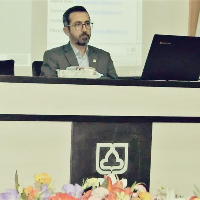Semiotic analysis of the phonetic level of the Bad al-Nabi ode
Muhammad Saeed Al Mansouri focused his poetry on the Prophet’s Famely, praise and lament. Among the poetry of lamentation, we chose the poem “After the Prophet” in the lamentation of Mrs. Fatima Al-Zahra (AS), in order to analyze it artistically, depending on the stylistic approach, focusing in our research on the phonetic level, which is represented in the external music, where we showed the poetic meter and its slips, and rhyme and its letters, especially the letter Al-Rawi and its vowels, and the internal music, as we stopped at the creative arts and repetition in all its forms. The research concluded that the poet was successful in his choice of the Al-Kamil meter, with a lot of benefit from the slithering and broken hamza in the narration of his poem, as the coming of the broken narrator suggests a broken psychological state, introverted on itself because of the kasra and the letter (yaa) that extends to the poet used the arts of anaphora and repetition to give his poetry a sound energy that helps to enhance the meanings of Zahra’s grief. He used three kinds of anaphora and repeated the words in three forms: The unverbal repetition to emphesise that the sorrow in Zahra’s heart is the same illness that killed her, the verbal repetition that is not for emphasis at all, but rather to find an additional meaning for an arithmetic purpose, and the repetition of the word verbally and meaningly, represented by the repetition of the words of sadness and crying to suggest the strong presence of the case of Zahra in the mind of the poet, because it is the basic element on which the text is built, as it reveals the desire of the poet. In the whispered sounds of which it is repeated (137 letters), the letter Taa (38 times) and Haa (37 times) are repeated, while the letter Lam (75 times) and Mim (46 times) are repeated in the voiced sounds.
-
A critical discourse analysis study of Barid Al-Lail (explanation and interpretation levels)
*, Reyhane Emami Chahartagh
Studies in Arabic Narratology journal, -
The semantics of the word “dispute” based on the seven types of Izutsu's simultaneous semantic theory
Sakineh Mosavi Asl, Shaker Ameri *, Ali Akbar Noresideh
Journal Of Linguistic and Rhetorical Studies,


